Yong SheeMun , Mohamad Nadzli Suhaimi , Shahida Syafiqah Abdullah , Shahhar Abdul Rahman , Nik Kamariah Nik Mat
Othman Yeop Abdullah Graduate School of Business, Universiti Utara Malaysia, Sintok, 06010, Malaysia
Correspondence to: Yong SheeMun , Othman Yeop Abdullah Graduate School of Business, Universiti Utara Malaysia, Sintok, 06010, Malaysia.
| Email: |  |
Copyright © 2012 Scientific & Academic Publishing. All Rights Reserved.
Abstract
Employee engagement is a major problem in a private sector in Malaysia. This problem needs to be addressed urgently in order to cope with the uncertainty of turbulent industry condition. This paper attempts to determine the antecedents of employee engagement such as job autonomy, strategic attention, role benefit and goal setting in private sector in Malaysia. A survey method was used to collect 204 responses from private sector employees in Malaysia which are engaged in telecommunication, finance, IT, property and plantation. The result of the regression analysis has shown tremendous outcome indicated that job autonomy, goal setting and role benefit had significant effect on employee engagement in private sector industries. This study has given an important role to the organization in developing strategy for their human resource development to enhance productivity and reducing cost of hiring new employees.
Keywords:
Employee Engagement, Job Satisfaction, Management Strategy, Private Sector, Malaysia
Cite this paper: Yong SheeMun , Mohamad Nadzli Suhaimi , Shahida Syafiqah Abdullah , Shahhar Abdul Rahman , Nik Kamariah Nik Mat , Employee Engagement: A Study from the Private Sector in Malaysia, Human Resource Management Research, Vol. 3 No. 1, 2013, pp. 43-48. doi: 10.5923/j.hrmr.20130301.09.
1. Introduction
Employee engagement has received a great deal of attention in the last decade in the popular business press and among consulting firms and the practitioner community. They claim employee engagement is a new human resource practice that business organizations can use in order to cope with the uncertainty of turbulent industry conditions. However, in the academic community, the concept remains new, and therefore, the concept require rigorous seminal studies to validate it. Given that practical interest in work engagement has outstripped the currently available research evidence, fundamental questions, like how it can be increased and how and why it benefits individuals and organizations, still require answers. This empirical research aims to attempts to determine by introducing goal setting into the antecedents of autonomy, strategic attention and role benefit would further increase employee engagement. For future study, it will serve as mediator to increase employees’ innovative behavior. The study designed to explore employees from private sector industries i.e. telecommunication, finance, IT, property and plantation in Malaysia. In accordance with the purpose and objectives of the study, 4 hypotheses were proposed based on several theories: Kahn's three psychological conditions theory, job demands-resources model, social exchange theory, and conservation of resources theory. Given that employee engagement is an important current issue for private sector industries i.e. telecommunication, finance, IT, property and plantation in Malaysia, the findings should provide the private sector industries with a more complete picture of how employee engagement will drive the overall productivity and profitability of an organization.
2. Literature Review
Employee engagement is a management concept that determines how involved and enthusiastic an employee is on his work that he creates a positive influence on his co-workers that would further enhance the interest of their workplace. Scarlett Surveys International suggests that management is perceived to have control in shaping the attitude and emotional state of their employees and managing this perception would bring about positive experiences that can simulate the intrinsic desire for greater work performance.Employee Engagement as a research is not new. Many studies were carried out in the past covering a wide spectrum of contributors and predictors. Notable recent studies include Natti et al (2011), Prabhakar (2011), Chughtai & Buckley (2011), Saks & Gruman (2011) with the latest conducted by Anaza & Rutherford in 2012. These studies were mostly concentrated in Europe and North America with a few contributions from Australia covering industries ranging from Finance, Telecommunication, Education to Medical and Tourism industries. In these studies, the authors have considered employee engagement as a process supported by a range of factors including communication, empowerment to make decision and supervisory support and not just the tangible reward factors. Saks (2006) in his research said that the Social Exchange Theory (SET) in its theoretical foundation explain the different level of engagement found in work places and organizations. In terms of Kahn’s (1990) definition, the obligation by employees in involving themselves more deeply in their roles within the organization depends on the resources that they received from their organization. In this context, when the organization does not provide these resources, it is highly likely that the employees withdraw and disengage themselves from their role. At the local front, a study was previously carried by Shahril (2010) on Employee Engagement in Malaysia’s Education. In his research, he posited that communication, career development and rewards & recognition are determinants towards an increase in Employee Engagement. His findings showed a positive significant relation between Rewards & Recognition and Employee Engagement which supported the hypothesis that Rewards & Recognition and Employee Engagement are directly related. In addition, Rewards & Recognition is a strong predictor for Employee Engagement.Base Models’ Past Studies Hypotheses Slatten & Mehmetoglu (2011) has in their study demonstrated the effect of the employee engagement on innovative behavior. The study further revealed that there is an explicate connection between perceived role benefit and engagement the point to individual employee perceptions of career opportunities and professional visibility. The study considers job autonomy as the freedom and independence that linked to employee engagement. Finally, they posited that before a strategy can be achieved the promised results, a close link between strategy as a plan and strategy as an act is vital. These hypotheses are transposed graphically as follow: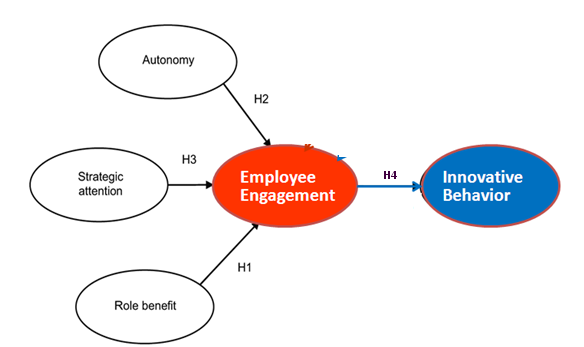 Medlin & Green (2009) in the study on Employee Engagement posited that effective goal setting is a driver of individual performance. There was significant evidence that suggest employees with high levels of optimism tend to perform at a higher level than other employees. The evidence also shows that engaged employees are performing at a higher level compare to those who are not engaged. This established a close relationship between the two constructs as illustrated below:
Medlin & Green (2009) in the study on Employee Engagement posited that effective goal setting is a driver of individual performance. There was significant evidence that suggest employees with high levels of optimism tend to perform at a higher level than other employees. The evidence also shows that engaged employees are performing at a higher level compare to those who are not engaged. This established a close relationship between the two constructs as illustrated below:
3. Methodology
3.1. Designed of Research Framework
This study has designed a new theoretical framework developed from past research studies conducted by Slatten & Mehmetoglu (2011) and Medlin & Green (2009). The underpinning research framework from Slatten & Mehmetoglu (2011) has been upgraded by adding a new antecedent variable of Goal Setting from Medlin & Green (2009) beside the other antecedent variables of Job Autonomy, Strategic Attention and Role Benefit. These research framework hypotheses were positively related to the Employee Engagement according to the past research studies (Figure 1).This study is evaluated to the stage of the Employee Engagement only, even though past studies from Slatten & Mehmetoglu (2011) and Medlin & Green (2009) were researching further up to the Innovative Behaviour and Individual Performance perspectives. | Figure 1. Theoretical Framework |
3.2. Structured Survey
The survey data related to this study were collected from private sector employees in Malaysia which are engaged in the business of telecommunication, finance, information technology, property and plantation. The employee involvement was range including their age, gender, academic qualification, job category and total year of work exprience levels. Set of questionnaires were structured from the past research studies from Slatten & Mehmetoglu (2011), Medlin & Green Jr (2009), King (2010), Taipale & Selander (2011),Vanam (2009) and Saks (2006). These set of questionnaires were evaluated and validated its readability and understandability by the authors, but some questions have been modified slightly to fit the aims of this study.This structured survey consists of two main sections which is Section A, respondent background (5 characteristics) and Section B, set of questionnaires (29 questionnaires) from the sub-section of Company Goal Setting, Job Autonomy, Strategic Attention, Role Benefit & Employee Engagement. In Section A, respondent has to answer about their socio-demographic characteristics including age, gender, level of education, job category and total year of work experience by selecting the appropriate boxes. While in Section B, the prospect respondent has to respond to a seven-point of Likert-type scale for all questionnaires. These measures were anchored at (7) strongly agree and (1) strongly disagree.
3.3. Analysis Methods
Each item is checked for its reliability (Cronbach Alpha). These items are further analyzed using descriptive statistics. Multi-Collinearity among the variables is checked and tested using Variance Inflation Factor (VIF) from collinearity diagnosis. Step-Wise Multiple Regression technique is used to identify the significant of independent variables influencing employee engagement. The summary reliability results in Table 1 shows that the overall Cronbach Alpha values are above 0.6 for all measures indicating acceptable internal consistency and reliability (Nunnally, 1978).  | Figure 2. Measurement Scales |
Table 1. Summary Reliability Coefficient
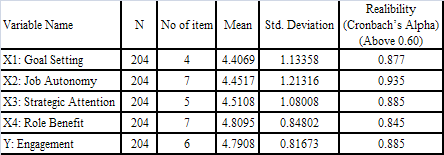 |
| |
|
4. Results
From Table 2, data were collected from 204 employees as valid responses from selected private sectors in Malaysia by the way of random proportionate sampling method. The sample consisted of 54.4% of female and 45.6% of male respondents. It was covered at the level of age between 25 to 35 years was 38.7%, 35 to 44 years (28.4%), below 25 years (16.75%), 45 to 54 years (14.7%) and above 55 years was 1.5%from the total characteristic of age. Moreover, degree holders are the highest respondents by 46.6% followed by diploma (34.3%), secondary (9.3%), master (8.8%) and PhD (1%) from the total characteristic of academic qualification and most of them are from executive level by 59.8%, managerial (23.0%) and non-executive was 17.2%. Respondents with the work experiences from 2 to 5 years were among the highest contribution by 28.9% to the survey followed by more than 10 years (26.5%), 6 to 8 years (23.0%), below 2 years (12.7%) and 8 to 10 years was 8.8%.Table 2. The Profile of Respondents (N=204)
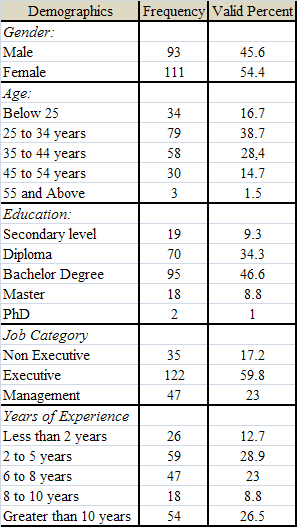 |
| |
|
Regression analysis method was used in the analysis of the data and subsequently be used to validate the framework hypothesis. The SPSS version 20 was used to analyze and examine this study suggested model framework. Apparently, the reliability test of Cronbach’s Alpha show all variables were above the scale of 0.6 which indicated sufficiently reliable internal consistency.Results of hypothesis testing showed that we have to drop the independent variable i.e. strategic attention as it fell below the total variance required to be considered as a factor during Factor Analysis. The other three (3) independent variables i.e. Job Autonomy, Goal Setting and Role Benefit positively influence Employee Engagement (Figure 3).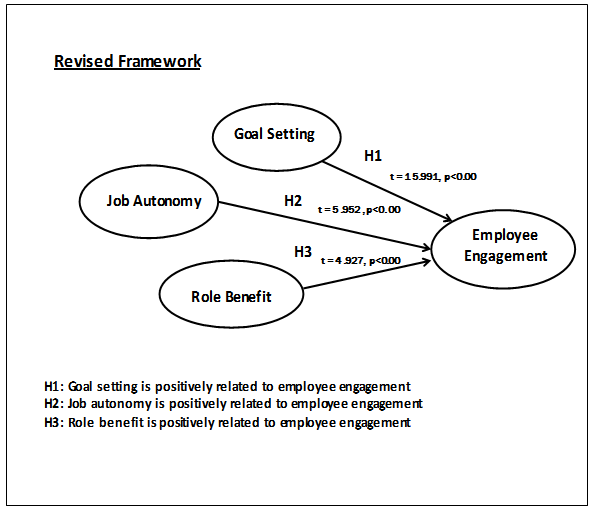 | Figure 3. Revised Framework |
The correlation results exhibited in Table 3 shows a relative significant correlation between all variables examined. Table 3. Correlation Matrix Table
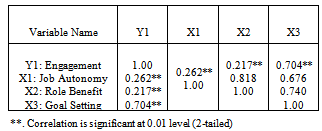 |
| |
|
Table 4. Step-Wise Multiple Regression Influence on Employee Engagement
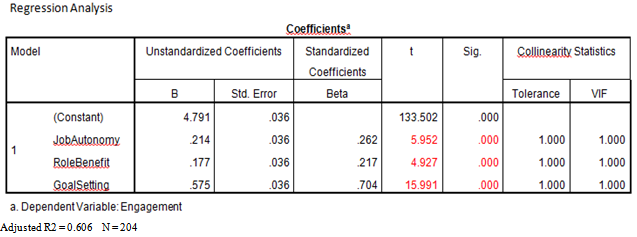 |
| |
|
From Table 4, multiple regression results indicate that three (3) independent variables are significant predictors of employee engagement. From Table 5, The R Square result is 0.612 which means approximately 61% of the variance of Employee engagement accounted by the model.Table 5. R Square
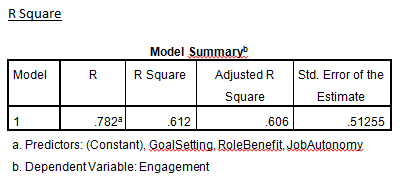 |
| |
|
5. Limitation of Research
Only few independent variables were considered in this study, although we can contribute with the other independent variables such as reward & recognition, job resources, trust in supervisor & job characteristic from the past studies.Survey collected only 204 respondents which was covered the small amount of employees in private sector compared with the 9thMalaysian Plan projection 2010 of sector in Agriculture, Finance, Insurance, Real Estate, Business Services, Transport, Storage & Communications is about 2.9 million employees.
6. Discussion
The study attempts to examine the relationship between 4 antecedents of employee engagement in private sector. After the factor analysis conducted, it has been determine that only 3 antecedents to be examined with employee engagement. The conceptual underpinning used is the theory of planned behaviour (Icek Ajzen, 2006)The study supported the following 3 hypotheses:-1) Autonomy important as it allows employee a freedom and independence in making the decision. This eventually will increase employee engagement in tandem with higher level of job autonomy.2) For goal setting, the study shows a significant relationship between the construct goal setting and employee engagement, which this means a higher level of employee engagement compare with those employees who are not given the goal setting. 3) For role benefit , the employee who given the trust to carry out the duties hence to achieve a higher level of engagement that ultimately benefits the whole organizationThe variance on gender for all constructs show a higher male variance in comparison with the female employees. It also shows the male employees have higher involvement in the office setting compared to female employees. The more seniority of an employee is the more engaged the employee has with the company. The level of academic qualification of an employee also determines an increase of his engagement in the company.
The level of academic qualification of an employee also determines an increase of his engagement in the company. 
7. Suggestion for Future Research
One of the considerations for future research should be given to extending the current study to include using Employee Engagement as the mediator between the antecedents of Work Autonomy, Role Benefit, Strategic Attention and Goal Setting, and the impact it has on the level of Innovative Behavior. This would allow us to further understand the motivation of individuals in exhibiting innovation in their work place given the right factors that drive those behaviors.The findings could not be generalized for the whole of Malaysia because it was only conducted in selected area in Klang Valley and only a few participants of the survey from outside Klang Valley.This model has shown some interesting findings which could be applied for utilization in research on a bigger scale to include the whole of Malaysia.
8. Conclusions
The employee engagement was a major problem in private sector in Malaysia. The purpose of the study was to determine relationship between the dependent variables i.e. employee engagement with the independent variables such as goal setting, job autonomy and role benefit. Multiples regression was used to determine the relationship between the dependent variable and independent variables.This study has established three direct causal effects: ⅰ. Goal Setting is positively significant effect to the Employee Engagement; ⅱ. Job Autonomy is positively significant effect to the Employee Engagement andⅲ.Role Benefit is positively significant effect to the Employee Engagement.In conclusion, this study has given an important role to the organization i.e. private sector in Malaysia on how to develop strategy in relation to their employee job satisfaction. Increases in the employee job satisfaction will enhance employee and organization productivity and furthermore decreased in expenses of hiring new employee. Higher productivity and lower company expenses will increase in company profits and also the government income in taxation.
ACKNOWLEDGEMENTS
We would like to take this opportunity to thank Prof. Dr. Nik Kamariah Nik Mat for her invaluable guidance, patience and support.
References
| [1] | Ajzen I. (2006). Theory of planned behavior. Retrieved November 19, 2011, fromhttp://www.people.umass.edu/aizen/index.html |
| [2] | Anaza, N. A., & Rutherford, B. N. (2012). Developing our understanding of patronizing frontline employees.Journal of Managing Service Quality, 22 (4), 340–358. |
| [3] | Chughtai, A. A, & Buckley, F. (2011). Work engagement: antecedents, the mediating role of learning goal orientation and job performance. Journal of Career Development International, 16 (7), 684–705. |
| [4] | Kahn, W. A. (1990). Psychological conditions of personal engagement and disengagement at work. Academy of Management Journal, 33, 692-724 |
| [5] | King, C. (2010). “One size doesn’t fit all” Tourism and hospitality employees’ response to internal brand management. International Journal of Contemporary Hospitality Management, 22 (4), 517–534. |
| [6] | Lee, H. (2004). The role of competence-based trust and organizational identification in continuous improvement. Journal of Managerial Psychology, 19 (6), 623–639. |
| [7] | Medlin, B., & Green Jr, K. W. (2009). Enhancing performance through goal setting, engagement and optimism. Journal of Industrial Management & Data Systems, 109 (7), 943–956. |
| [8] | Nätti, J., Tammelin, M., Anttila, T. and Ojala, S. (2011) ‘Work at home and time use in Finland’, New Technology, Work and Employment 26(1): 68–77. |
| [9] | Ram, P., & Prabhakar, G. V. (2011). The role of employee engagement in work-related outcomes. Journal: Interdisciplinary Journal of Research in Business Year, 1 (3), 47–61. |
| [10] | Saks, A. M., & Gruman, J. A. (2011). Getting newcomers engaged: the role of socialization tactics. Journal of Managerial Psychology, 26 (5), 383–402. |
| [11] | Saks, A. M. (2006). Antecedents and consequences of employee engagement. Journal of Managerial Psychology, 21 (7). |
| [12] | Online available at Scarlett Surveys International, http://www.scarlettsurveys.com/. |
| [13] | Rini Wati, Shahril (2010). Employee Engagement in Malaysia's Education Industry: A Survey of Cosmopoint, Kuala Lumpur. Masters thesis, Universiti Utara Malaysia. |
| [14] | Slatten, T. & Mehmetoglu, M. (2011). Antecedents and effects of engaged frontline employees: A study from the hospitality industry. Journal of Managing Service Quality, 21 (1), 88–107. |
| [15] | Taipale, S., Selander, K., Anttila, T, & Natti, J. (2011). Work engagement in eight European countries: The role of job demands, autonomy, and social support. International Journal of Sociology and Social Policy, 31 (7/8). |
| [16] | Vanam, S. (2009). “Job engagement: examining the relationship with situational and personal factors”. Master's Theses,Paper 3349.http://scholarworks.sjsu.edu/etd_theses/3349. |

 Medlin & Green (2009) in the study on Employee Engagement posited that effective goal setting is a driver of individual performance. There was significant evidence that suggest employees with high levels of optimism tend to perform at a higher level than other employees. The evidence also shows that engaged employees are performing at a higher level compare to those who are not engaged. This established a close relationship between the two constructs as illustrated below:
Medlin & Green (2009) in the study on Employee Engagement posited that effective goal setting is a driver of individual performance. There was significant evidence that suggest employees with high levels of optimism tend to perform at a higher level than other employees. The evidence also shows that engaged employees are performing at a higher level compare to those who are not engaged. This established a close relationship between the two constructs as illustrated below:



 The level of academic qualification of an employee also determines an increase of his engagement in the company.
The level of academic qualification of an employee also determines an increase of his engagement in the company. 
 Abstract
Abstract Reference
Reference Full-Text PDF
Full-Text PDF Full-text HTML
Full-text HTML



